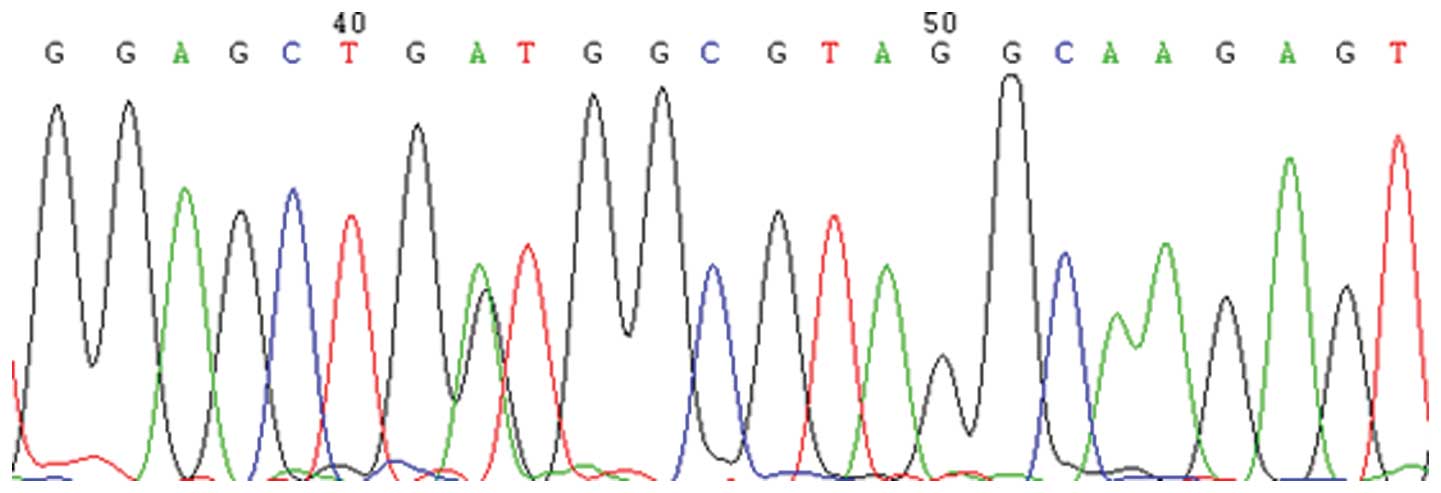|
1
|
Jemal A, Bray F, Center MM, Ferlay J, Ward
E and Forman D: Global cancer statistics. CA Cancer J Clin.
61:69–90. 2011.
|
|
2
|
Siegel R, Naishadham D and Jemal A: Cancer
statistics, 2013. CA Cancer J Clin. 63:11–30. 2013.
|
|
3
|
Kiaris H and Spandidos DA: Mutations of
ras genes in human tumours. International Journal of Oncology.
7:413–429. 1995.
|
|
4
|
Schubbert S, Shannon K and Bollag G:
Hyperactive Ras in developmental disorders and cancer. Nat Rev
Cancer. 7:295–308. 2007.
|
|
5
|
Bos JL, Fearon ER, Hamilton SR, et al:
Prevalence of ras gene mutations in human colorectal cancers.
Nature. 327:293–297. 1987.
|
|
6
|
Benvenuti S, Sartore-Bianchi A, Di
Nicolantonio F, et al: Oncogenic activation of the RAS/RAF
signaling pathway impairs the response of metastatic colorectal
cancers to anti-epidermal growth factor receptor antibody
therapies. Cancer Res. 67:2643–2648. 2007.
|
|
7
|
Lilleberg SL, Durocher J, Sanders C,
Walters K and Culver K: High sensitivity scanning of colorectal
tumors and matched plasma DNA for mutations in APC, TP53, K-RAS,
and BRAF genes with a novel DHPLC fluorescence detection platform.
Ann NY Acad Sci. 1022:250–256. 2004.
|
|
8
|
Mostert B, Jiang Y, Sieuwerts AM, et al:
KRAS and BRAF mutation status in circulating colorectal tumor cells
and their correlation with primary and metastatic tumor tissue. Int
J Cancer. 133:130–141. 2013.
|
|
9
|
Abdul Murad NA, Othman Z, Khalid M, et al:
Missense mutations in MLH1, MSH2, KRAS, and APC genes in colorectal
cancer patients in Malaysia. Dig Dis Sci. 57:2863–2872. 2012.
|
|
10
|
Sinha R, Hussain S, Mehrotra R, et al:
Kras gene mutation and RASSF1A, FHIT and MGMT gene promoter
hypermethylation: indicators of tumor staging and metastasis in
adenocarcinomatous sporadic colorectal cancer in Indian population.
PLoS One. 8:e601422013.
|
|
11
|
Bando H, Yoshino T, Tsuchihara K, et al:
KRAS mutations detected by the amplification refractory mutation
system-Scorpion assays strongly correlate with therapeutic effect
of cetuximab. Br J Cancer. 105:403–406. 2011.
|
|
12
|
Li J and Makrigiorgos GM: COLD-PCR: a new
platform for highly improved mutation detection in cancer and
genetic testing. Biochem Soc Trans. 37:427–432. 2009.
|
|
13
|
Zuo Z, Chen SS, Chandra PK, et al:
Application of COLD-PCR for improved detection of KRAS mutations in
clinical samples. Mod Pathol. 22:1023–1031. 2009.
|
|
14
|
Carotenuto P, Roma C, Cozzolino S, et al:
Detection of KRAS mutations in colorectal cancer with Fast
COLD-PCR. Int J Oncol. 40:378–384. 2012.
|
|
15
|
Pennycuick A, Simpson T, Crawley D, et al:
Routine EGFR and KRAS mutation analysis using COLD-PCR in non-small
cell lung cancer. Int J Clin Pract. 66:748–752. 2012.
|
|
16
|
Allegra CJ, Jessup JM, Somerfield MR, et
al: American Society of Clinical Oncology provisional clinical
opinion: testing for KRAS gene mutations in patients with
metastatic colorectal carcinoma to predict response to
anti-epidermal growth factor receptor monoclonal antibody therapy.
J Clin Oncol. 27:2091–2096. 2009.
|
|
17
|
De Roock W, Claes B, Bernasconi D, et al:
Effects of KRAS, BRAF, NRAS, and PIK3CA mutations on the efficacy
of cetuximab plus chemotherapy in chemotherapy-refractory
metastatic colorectal cancer: a retrospective consortium analysis.
Lancet Oncol. 11:753–762. 2010.
|















